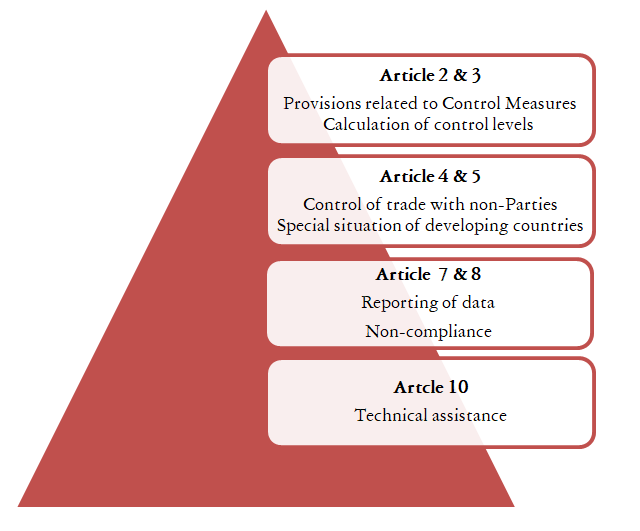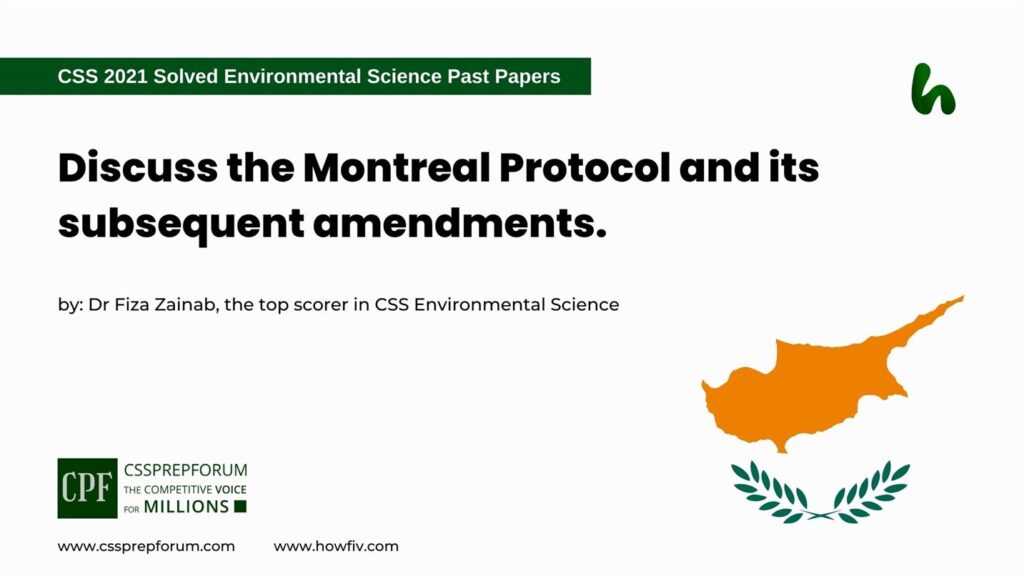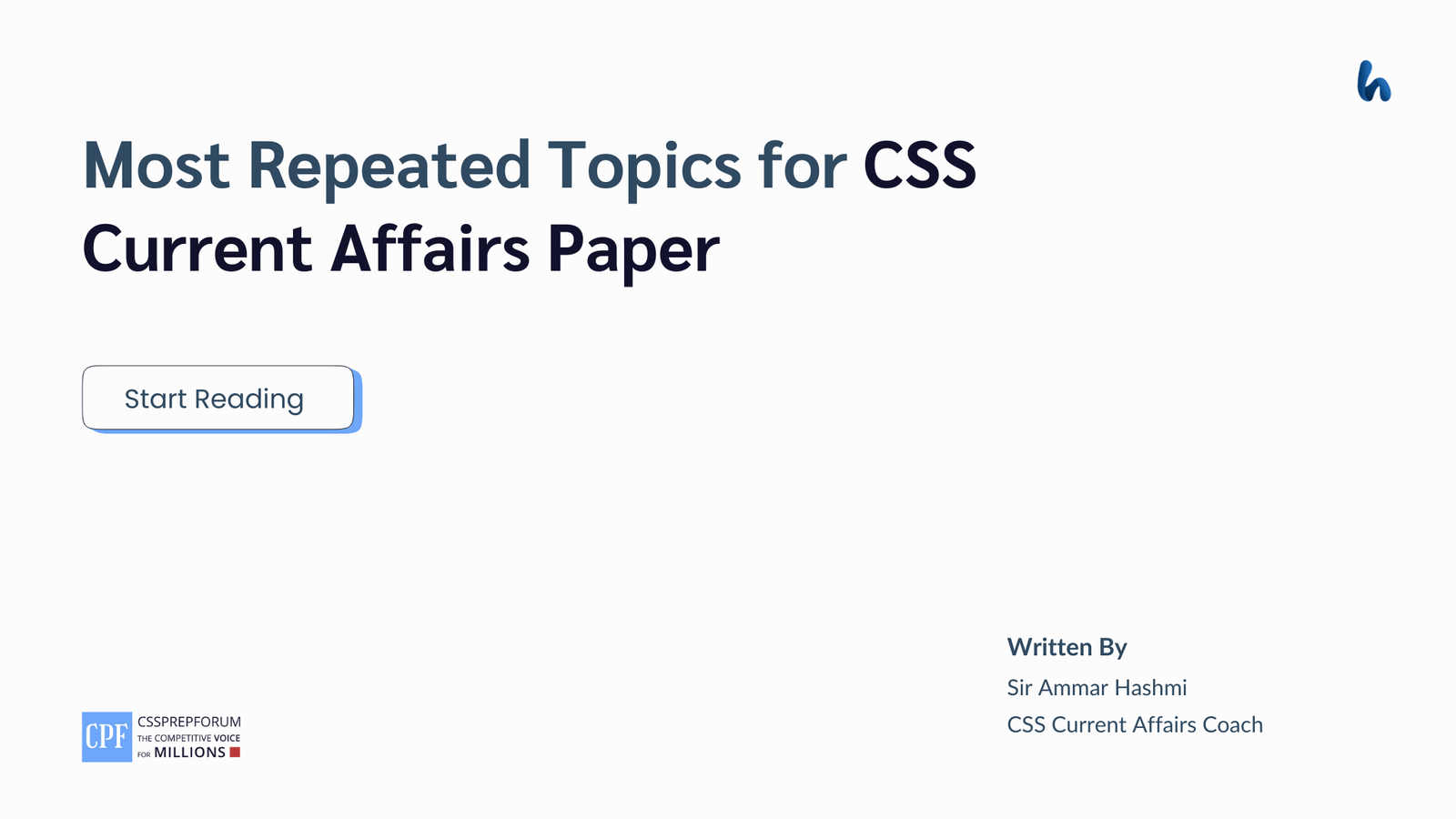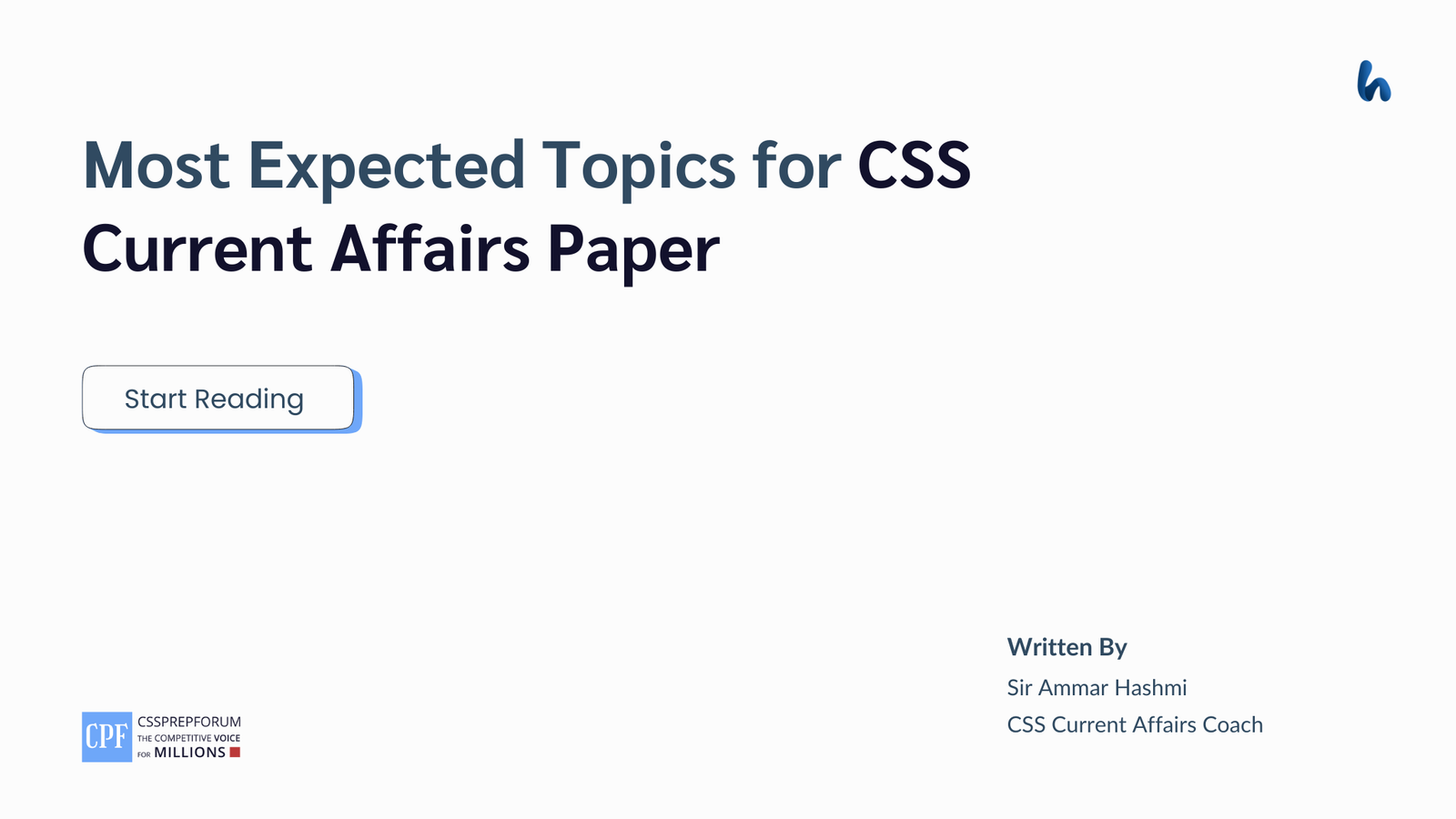CSS Solved Environmental Science Past Papers | Discuss the Montreal Protocol and its subsequent amendments.
The following question of Environmental Science is attempted on the same pattern, taught by Sir to his students, scoring the highest marks in compulsory subjects for years. This solved past paper question is uploaded to help aspirants understand how to crack a topic or question, how to write relevantly, what coherence is, and how to include and connect ideas, opinions, and suggestions to score the maximum.

Question Breakdown
The examiner expects you to provide a clear overview of the concept of Montreal Protocol, its key objectives, and its subsequent amendments. Make a comprehensive and convincing outline that covers every relevant aspect of your answer that you are to be covered in your answer. By the following outline, you can ensure that you address all the key aspects of the prompt and present a logical and coherent argument. You can make easy and simple diagrams to strengthen your answer. Further, you can validate your answer by providing authentic references from the international community.
Outline
1- Introduction
2- Historical background of the Montreal Protocol
3- Implementation of the Montreal Protocol
4- The Multilateral Fund- Article 10 of the protocol
5- Amendments of the Montreal Protocol
- ✓The London Amendment -1990
- ✓The Copenhagen Amendment-1992
- ✓The Montreal Amendment-1997
- ✓The Beijing Amendment-1999
- ✓The Kigali Amendment-2016
6- Significance of Kigali amendment -Phase down of HFCs
7- Success achieved to date and the job ahead
8- Conclusion

Answer to the Question
Introduction
“Perhaps the single most successful international environmental agreement to date has been the Montreal Protocol, in which states accepted the need to phase out the use of ozone-depleting substances.”
_____ Kofi Annan (7th Secretary General of the United Nations)
Montreal Protocol is a landmark multilateral environmental agreement that regulates the production and consumption of nearly 100 man-made chemicals that are usually named ozone layer-depleting substances (ODS). It is scientifically evaluated that when these chemicals are released into the atmosphere, they chemically interact with stratospheric good ozone. This ozone is a protective layer around our earth that protects biotic and abiotic components of the earth from deadly impacts of ultraviolet radiations. Montreal Protocol is adopted on the 16th of September 1987 under the umbrella of the Vienna Convention and entered into force in 1989. It was specifically designed to reduce the concentration of ODS in the atmosphere to protect the earth’s protective shield. It provides a set of practical and actionable tasks that were universally agreed on. The protocol parties meet once a year to evaluate the progress of the protocol in order to make any required and desired changes. To date, the protocol has been amended five times and the most recent amendment is the Kigali amendment which was enforced in 2016 to phase down hydrofluorocarbons (HFCs). The protocol is successful in its dealings and it is a collaborative effort of nations around the world.
Historical background of the Montreal Protocol
By 1985, the globe had already seen advancements in the scientific understanding of ozone depletion and its impacts on human health and the environment. The Vienna Convention was created in response to the Protection of the Ozone Layer. The Vienna Convention was the first convention of its unique kind to be signed by every country involved, taking effect in 1988 and reaching universal ratification in 2009. The Convention aimed to promote cooperation among nations by exchanging information and authentic data on the effects of human activities on the ozone layer. In doing so, the creators of the Convention hoped policymakers would adopt measures to combat those activities responsible for ozone depletion. It was drafted following an international discussion of scientific discoveries in the 1970s and 1980s highlighting the adverse effect of human activity on ozone levels in the stratosphere and the discovery of the ‘ozone hole’. This would come later in the form of the Montreal Protocol.

Implementation of the Montreal Protocol
The Montreal Protocol –a landmark environmental agreement- aimed at the purpose of production and consumption of various ozone-depleting substances in a step-wise manner. These steps were created on different timelines for developed and developing countries. It was highlighted in Article 5 of the treaty. Under this agreement, all the participating parties (Developed & Non developed countries) are supposed to share equal but differential responsibilities. One important thing is that both parties have binding, time-targeted and measurable commitments.

The Multilateral Fund- Article 10 of the protocol
The parties meet once on an annual basis. The parties are assisted in terms of scientific and technical domains by the Ozone Secretariat, which is based at the UN Environment Programme headquarters in Nairobi, Kenya.
Under Article 10 of the agreement, the Multilateral Fund for the Implementation of the Montreal Protocol was created in 1991. The Fund’s goal is to provide technical and financial assistance to developing nations that are party to the Montreal Protocol and whose annual per capita consumption and production of ODS is less than 0.3 kg. Four international organizations, the UN Environment Programme (UNEP), UN Development Programme (UNDP), UN Industrial Development Organization (UNIDO), and the World Bank, along with bilateral organizations from non-Article 5 nations, carry out the functions of the Multilateral Fund. The Executive Committee, which consists of seven members each from Article 5 nations and non-Article 5 countries, is in charge of overseeing the management of the Fund. The Multilateral Fund Secretariat assists the Committee.

Over 8,600 projects worth US$3.9 billion have received funding from the Multilateral Fund since its inception, including industrial conversion, technical assistance, training, and capacity building.
Amendments of Montreal Protocol
The treaty evolves over time in light of new scientific, technical and economic developments, and it continues to be amended and adjusted. Some important amendments are given below:
- ✓The London Amendment -1990
This amendment was agreed by the Second Meeting of the Parties (London, 27-29 June 1990). In London amendment the required time period for the complete phase out of CFCs, halons, and carbon tetrachloride was changed. ODS omission schedule was changed by 2000 in developed countries, and by 2010 in developing countries. Along with it, Methyl chloroform was also added to the list of controlled ODSs, with phase-out in developed countries targeted in 2005, and in 2015 for developing countries.
- ✓The Copenhagen Amendment-1992
This amendment was agreed by the Fourth Meeting of the Parties (Copenhagen, 23-25 November 1992). It greatly sped up the phase-out of ODSs by incorporating hydrochlorofluorocarbons (HCFC) for developed countries starting in 2004. This agreement set the year 1996 as the aim for the complete phase out of CFCs, halons, carbon tetrachloride, and methyl chloroform in industrialized nations. Additionally, the consumption of methyl bromide was restricted to levels from 1991.
- ✓The Montreal Amendment-1997
This amendment was agreed by the 9th Meeting of the Parties (Montreal, 15-17 September 1997). This amendment paved a way to phase out HCFCs in developing countries. It also targeted to phase the methyl bromide completely out from developed and developing parties of the protocol in 2005 and 2015, respectively.
- ✓The Beijing Amendment-1999
This amendment was agreed by the 11th Meeting of the Parties (Beijing, 29 Nov-3 Dec 1999). This amendment was done to ensure the tightened control and regulation of HCFCs. Additionally, bromochloromethane was added to the list of prohibited products, and its phase-out was scheduled to begin in 2004.
- ✓The Kigali Amendment-2016
The Parties to the Montreal Protocol reached an agreement at their 28th Meeting of the Parties on 15 October 2016 in Kigali, Rwanda to phase down HFCs. Parties agreed to add HFCs to the list of controlled substances, and a timeline for their gradual reduction by 80-85 per cent by the late 2040s was approved. The first reductions by developed countries are expected in 2019. Developing countries will follow with a cut down of HFC consumption levels in 2024 and in 2028 for some nations. The success of the Kigali agreement is considered as a continuation of the historical legacy of the Montreal Protocol. The Kigali Amendment was entered into force on 1 January 2019 for those countries that have ratified the amendment.

Significance of Kigali amendment -Phase down of HFCs
The Kigali Agreement is a significant milestone in the global effort to address climate change. Prior to this agreement, the Montreal Protocol only regulated substances that were harmful to the ozone layer. However, HFCs, which have high global warming potential, do not have an impact on the ozone layer. The expansion of the treaty’s scope to include HFCs represents a new era for the Montreal Protocol to phase out substances with high global warming potential. In the past, the use of HFCs increased, particularly in the refrigeration and air conditioning sector. The Kigali Agreement will require further interventions in this sector to phase down the use of HFCs. This is expected to prevent an increase in atmospheric temperature of 0.5°C by the end of the century and could reduce the emission of CO2 equivalents in the atmosphere by 70 billion tons by 2050. The Kigali Agreement also highlights the importance of energy efficiency. The increasing demand for refrigeration and air conditioning may result in an 80% rise in electricity usage from 2010 to 2100. HFCs can contribute to global warming through direct refrigerant leakage and indirect emissions from refrigeration equipment. Improving the energy efficiency of refrigeration systems is; therefore, a crucial part of climate change mitigation and a key goal for future projects.
The success achieved to date and the job ahead
By the middle of this century, the ozone layer is expected to recover with the entire and sustained implementation of the Montreal Protocol. Without this agreement, ozone depletion would have tripled by the decade of 2050 compared to current levels, producing millions more cases of melanoma, various cancers, and cataracts in the eyes. For instance, it has been predicted that the Montreal Protocol will prevent skin cancer in two million individuals annually by the year 2030.
The Kigali Amendment stipulates that measures to reduce the utilization of HFCs as outlined in the Montreal Protocol are anticipated to prevent the discharge of up to 105 million tons of carbon dioxide equivalent in greenhouse gases. This action will assist in avoiding a temperature rise of up to 0.5 degrees Celsius by 2100, which is an extraordinary effort towards climate change mitigation. It represents the most significant contribution the world has ever made in its quest to restrict global temperature rise to “well below” 2 degrees Celsius, a target that was agreed upon at the Paris climate conference.

The Montreal Protocol also makes important contributions to the realization of the UN Sustainable Development Goals.
Conclusion
In conclusion, it is important to note that the Montreal Protocol and its subsequent amendments have been crucial in addressing the escalating ozone depletion and climate change issues. The Protocol has successfully phased out ozone-depleting compounds through international cooperation, and this has made a significant contribution to the ozone layer’s recovery. By phasing out more substances and tackling new difficulties, the Protocol’s modifications have increased its effectiveness. The achievement of the Montreal Protocol is evidence of the value of international cooperation and the necessity of acting quickly to address pressing environmental issues. It continues to serve as a crucial framework for efforts to safeguard the environment and advance sustainable development.
CSS Solved Past Papers’ Essays
Looking for the last ten years of CSS and PMS Solved Essays and want to know how Sir Kazim’s students write and score the highest marks in the essays’ papers? Then, click on the CSS Solved Essays to start reading them.
CSS Solved Essays

CSS Solved General Science & Ability Past Papers
Want to read the last ten years’ General Science & Ability Solved Past Papers to learn how to attempt them and to score high? Let’s click on the link below to read them all freely. All past papers have been solved by Miss Iqra Ali & Dr Nishat Baloch, Pakistan’s top CSS GSA coach having the highest score of their students.
General Science & Ability Solved Past Papers
CSS Solved Pakistan Affairs Past Papers
Want to read CSS Pakistan Affairs Solved Past Papers and learn how to attempt them to score high? Let’s click on the link below to read them all freely. All past papers’ questions have been attempted by Sir Kazim’s students, who scored the highest in the subject.
CSS Solved Pakistan Affairs
CSS Solved International Relations’ Past Papers
Have you opted for International Relations in the CSS examination and want to score above 150? Then, click on the CSS Solved International Relations’ Past Papers by Miss Abeera Fatima, the top IR scorer and the best IR coach in Pakistan.
CSS Solved International Relations Past Papers
Articles Might Interest You!
The following are some of the most important articles for CSS and PMS aspirants. Click on any to start reading.












